
Related
Topics
Guests
- ZoriahAmerican journalist and war photographer. He was embedded with the Marine Corps in Anbar province in Iraq but is now barred from documenting the Marines because of photographs showing three Marines killed in a suicide bombing.
Links
An American photojournalist who was embedded with the Marines in Fallujah has been barred from the Marine Corps because of graphic photographs showing Marines killed in a suicide bombing last month. A few hours after he posted some photos of the bombing on his blog, a high-ranking public affairs official ordered him to remove it. When he refused, he was told his “embed” had been terminated and he would be flown out of Iraq. [includes rush transcript]
Transcript
AMY GOODMAN: An American photojournalist who was embedded with the Marines in Fallujah has been barred from the Marine Corps because of graphic photographs showing Marines killed in a suicide bombing last month.
The June 26th attack on a Fallujah city council meeting between local sheikhs and US military officials killed three Marines, two interpreters and twenty Iraqis. A few days after the bombing, the journalist who publishes under the name Zoriah posted some photographs of the scene on his blog at www.zoriah.net. A few hours later, a high-ranking public affairs official ordered him to remove the blog post. When Zoriah refused, he was told his “embed” had been terminated and he would be flown out of Iraq.
In his blog posting introducing the photographs, Zoriah wrote, “What I saw was abhorrently graphic, yet far too important for the world to ignore. I present images that provide an uncensored view of a terrible event, and some small measure of dignity to those who lost their lives.”
In a later posting, he wrote, “How can things change if all that comes out of Iraq are sanitized, white-washed images of war designed for mainstream media outlets who focus on making money, not on the quality and truth in what they report?”
After meeting with high-level officials in Iraq, Zoriah now retains his credentials, but he’s still barred from documenting US Marine operations.
Zoriah returned to the United States and joins me now from Littleton, Colorado. Welcome to Democracy Now!
ZORIAH: Thank you, Amy.
AMY GOODMAN: Can you talk about what happened? Talk about the day you photographed the — you took the photographs that you posted.
ZORIAH: Sure. It was actually my first day embedded with the Marine Corps. I had been in Iraq for several weeks already, documenting the situation from Sadr City with the US Army. It was the first day of my embed with the Marines, the morning of the 26th. We were on a security patrol in Anbar province when we received radio information that just down the street from where we were conducting a raid on a Iraqi home there had been some sort of massive blast.
We immediately grabbed our equipment, our body armor, our Kevlar and ran down the street about a block away from the location of the city council meeting. We started seeing people screaming and running and just general chaos. The soldier I was running next to and I looked on the ground, and we saw a human ear on the ground. A couple feet later, we saw what appeared to be possibly a skull cap with hair. And as we got closer to the building, we just saw more and more body parts and realized that what we were about to witness would be [audio dropped] —-
AMY GOODMAN: We’re talking to Zoriah. We may have just lost the feed to Littleton. It’s back. And I do just, though, want to warn our viewers that we are going to be showing some of his graphic photographs, and for our radio listeners, you can go to our website at democracynow.org. Zoriah, continue with your description.
ZORIAH: Yes. We walked around to the entrance of the building where they were holding the city council meeting that had suffered the attack. Upon walking through the door, it was just a scene of absolute horror. Twenty civilians, three Marines, several interpreters were basically just lying in pieces in the courtyard of this building. It was an open-air courtyard. The soldiers, as we went in, were, I think, in just as much shock as everyone else. Several were throwing up. It was just extremely graphic.
And I realized at that moment that it was a situation that I could very likely be removed from, knowing, you know, stories that several other journalists have told about trying to photograph under similar circumstances while embedded and that the soldiers, the Marines, really do not like this kind of information, especially when it’s their own that have been injured or killed, to be released.
So I immediately began to take as many pictures as I possibly could, which was a very good decision, because I was only allowed about five, maybe seven, minutes inside where the bomb blast had happened before I was told that I needed to leave the area. I was told it was for my own safety. I protested. I said, “I’m not worried about my own safety. I’m here to do my job. I’m here to document.” But they insisted.
I ended up spending about an hour and a half or two hours locked inside of an armored vehicle, and I was finally allowed back into the scene and told at that point that I was not allowed to take anymore photos. I could stand by if I wanted to and be witness, but I was not allowed to use my camera anymore at that point. My protests didn’t do anything. I tried to have them radio a higher command or a public affairs officer to, you know, get verification that I was allowed to take pictures of the scene, but that didn’t happen.
Later that day, when we returned to a base, one of the Marines told me that they needed to have me erase my memory cards and actually hand my memory cards over at that point. I refused to do that. And it was not taken any further at that point.
I waited the twenty-four hours for family to be notified, as per the media ground rules for embedded photographers or journalists. You’re not allowed to release any information until family has been notified. The next day, Friday the 27th, we got word that all the family members had been notified, and I still spent the three next days giving some extra time, knowing that the images I had taken were extremely graphic and would be hard for people to look at, and organizing my post on my blog so that if the family members or anyone else that knew these men happen to go on the blog by accident, they would actually have to read a disclaimer and go to a second page where the images were below the fold of the screen and there were more warnings about the graphic content and about the event.
I ended up posting the blog on the evening of the 30th, and within several hours after posting it, I received a call from senior PAO officials, public affairs officials, saying that they wanted my blog taken down completely, the entire blog, which I immediately refused to do. And within ten minutes of refusing to remove my blog, they called back. They asked one more time.
I asked them again what the reason for asking me to remove my blog was, and at the time they said that I had showed Marines, injured or killed Marines, and that they were identified as Marines because of their camouflage pants and their shoes. And I said, “Well, there’s nothing in the embed rules that say you can’t show someone who’s identifiable as a Marine. It says no identifiable features, you know, to identify that person from, you know, another person. But actually showing an injured soldier or a dead soldier is not something that is barred in the embed rules.” They claimed it was. They claimed that I had signed something that said that this was the case. I knew that I hadn’t.
And within several minutes, I had gotten word that they were arranging a special convoy to remove me from the area and take me to Camp Fallujah, where there was a flight to bring me to the Green Zone and away from all Marine installations.
Upon arrival at Camp Fallujah, I ended up being held there for three days. They had given me armed escorts, because they feared that people on the base were so angry that I could potentially be in harm’s way. The reason they claim they kept me at the base was to meet General Kelly, who was the senior commander there who wanted to speak with me about the photos I had taken and ask me again to take them down. The two times that I went to meet with him, he left me waiting, the first time for two hours, the first time for about -— or the second time for about a half an hour, and never showed up.
On the third day, they arranged a special helicopter flight to the Green Zone, at which time I was flown out of the Marines’ area of operation, and I assumed at that point that I would be continuing my embeds with the US Army, because most journalists who do get banned or barred because of similar circumstances end up just going on another embed immediately with a different branch of the military or sometimes just in a different area. Upon arrival in Baghdad, I was told that the Marines were pushing for my complete blacklisting in all DOD operations, any military operations, and that I would have to stand by until the situation was resolved.
Three days later, I had a — was invited to a dinner at the US embassy in Baghdad, where I was told that senior public affairs officials, basically as high up in the chain of command as you can get in Iraq, had been debating my case and had been listening to the claims that the Marines had made and had not found anything that I had done to be a breach of my contract, a breach of the embed rules, and that they would allow me to keep my credentials, although there was nothing they could do as far as the Marines go. My ban and barment from the Marine Corps stood, and there was no way that that would be lifted.
AMY GOODMAN: We’re talking to Zoriah, who was an embedded photographer with the Marines when he photographed a suicide bombing. The letter that you got giving the reasons for your dismissal said “you photographed the remains of U.S. soldiers,” “you posted these images along with detailed commentary,” and “by posting the images and your commentary you violated 14 H and O of the news media agreement you signed.” In addition, the letter said, “By providing detailed information of the effectiveness of the attack and response of US forces to it, you have put all US forces in Iraq at greater risk for harm.” Your response?
ZORIAH: Well, first of all, I did not report or show anything that had not already been shown by the New York Times, Washington Post, Reuters, the day after the attack. There were detailed reports of the attack on all major news media, even within hours of the attack. And none of the information I had given presented any new information and definitely no information that could be used by an enemy to plan an attack.
And I’ve received, since this incident, several emails from military public affairs officers and former military public affairs officers from around the world who have said that they’ve reviewed this extensively and that there’s absolutely nothing in my photographs or in my post that could be used by the enemy to gather any sort of information and that the clause that they actually used to formally disembed me with is primarily used for people who try to photograph vehicles that have been disabled by IEDs or EFPs, explosively formed projectiles, and that this clause was made so that people would not take images of these vehicles and thus giving the enemy specific information as to how their roadside bombs were disabling vehicles and, you know, if the placement was correct and how to better place their weapons to cause more damage.
AMY GOODMAN: Zoriah, did they want you to erase your memory card?
ZORIAH: Yes, that was the day of the attack. They asked me to erase my memory card. They actually asked me to erase my memory card and then wanted my cameras and memory cards handed over to them. That was the first thing I refused to do. They didn’t end up pushing that issue. I believe whoever it was that was pushing me to do that was told by someone else that that was absolutely not acceptable; otherwise, I don’t know why they didn’t push the issue more that day.
AMY GOODMAN: What was the response of the Marines on the ground, of the soldiers that you were embedded with, of the Marines that you were embedded with, to what you were doing, to your photographs and to your posting them?
ZORIAH: Well, you know, I mean, we live on a daily basis with these guys. We — you know, we develop relationships with them. We sleep in the same room. We live in the same rooms. We travel in vehicles. And, you know, we had actually, in a way, bonded through this event. It was such a, you know, horrific thing for all of us to witness, that I felt very close to the men in my platoon, and I think they felt the same way about me.
And one of the things that I did in the three days before I posted the blog, after the families had been notified, was work and speak with the Marines that I was staying with, asking them what they felt about the photos, if they felt that, you know, they were offensive, if they felt they were in bad taste, if they felt the post in general, you know, would be hurtful to family members, if they thought, you know, it did more good than bad. And I had the overwhelming support, and I continue to get letters from Marines all over the world who are pledging their support and saying that they think that my being barred from the Marine Corps was absolutely out of line.
AMY GOODMAN: We’re going to break, but when we come back, Zoriah, I want to ask you about what it was you felt you had agreed to in being embedded in the Marines. This is Democracy Now!, democracynow.org, the War and Peace Report. Zoriah is an American journalist, a war photographer embedded with the Marines, now barred from Anbar province by them for showing the photographs of dead Marines. He photographed a suicide bombing that killed three Marines. This is Democracy Now!, democracynow.org, the War and Peace Report. Back in a minute.
[break]
AMY GOODMAN: We continue with the American photojournalist, Zoriah, war photographer embedded with the Marine Corps at Anbar province in Iraq, now barred for documenting the Marines because of photographs showing three Marines killed in a suicide bombing that he posted to his website. What is the agreement you make with the military, Zoriah, when you are embedded? What is it that you sign?
ZORIAH: It’s called the media hold harmless agreement. There’s several different clauses and several different bits of information in it. The ones that pertain to this, to my case, are, first of all, you’re not allowed to publish any images that have identifiable features before the family of the soldier that has been killed has been notified. And by “identifiable features,” it’s referring to nametags, it’s referring to tattoos, it’s referring to clear shots that show the individual’s face, and you could say, you know, “I know who this person is.” And, you know, this is something that I followed to the letter, and even beyond it, I made sure that there were no identifiable features in the post, even after the family had been notified.
Like I said before, the other issue which they claim that I had violated, the official reason for the termination of my embed, had been providing the enemy with information on the effectiveness of attack. You know, I don’t see how you could have any photo that comes out of Iraq after an attack that, you know, they couldn’t say, if they wanted to, that this photo or this information could potentially provide the enemy with some information that they could use. I mean, pretty much any documentation of any — you know, even where an attack had been three weeks ago, you could use this clause to disembed somebody, which is the really kind of disheartening thing about this, is how incredibly easy it is to remove an embedded journalist under the system that they have now.
And I think another really interesting thing is the fact that the morning of, I guess — or the evening of the 30th, when I was officially notified that my embed would be terminated, the reason they gave me was that I had shown — I had depicted a Marine that was injured or killed and that was identifiable by the camouflage pants and the boots. Then, three days later, the official, in writing, reason for my termination of my embed was the fact that I had provided the enemy with information on the effectiveness of an attack.
By the time I got to Baghdad and the Marine Corps was pressing for my blacklist from all DOD operations and any further embeds, they were saying that I had changed a photo on the website that was originally posted and then I changed later. I was able to disprove that through records with TypePad, the company that hosts the blog.
And then, after that, they claimed that I had posted the blog before the families had been notified. And once again, we were able to use time stamps as to when the blog was published to disprove that and prove that it was literally several days after the family had gotten notification that the blog post came up.
So I think it’s very interesting how many times their story had changed. And it just — it makes me wonder, you know, if they were kind of grasping for straws trying to get a reason to, you know, get me blacklisted. And I do have to say that I’m very happy that the senior officials in Baghdad were able to see through that. They specifically told me, “The Marines have not been able to prove anything that they have claimed against you,” and that’s why I’m able to keep my credentials.
AMY GOODMAN: Zoriah, I wanted to turn now to an interview that I did with James Lee in Santa Barbara. He’s a former Marine from California who served two tours of duty in Iraq in 2001 to 2004. Now he’s a journalism student at San Francisco State University. He went back to Iraq earlier this year to file reports for the college newspaper. But in April, James Lee was abruptly disembedded.
JAMES LEE: My last assignment was in the city of Basra. I had become aware of a declining security situation in some neighborhoods around Baghdad and in Basra and decided that I wanted to go down and photograph to document the Iraqi army’s ability or inability to conduct independent combat operations in Iraq.
I arrived in Basra after a three-day convoy with Iraqi soldiers from Baghdad down to Basra. I was only in Basra about four hours, when I was notified by the public affairs office assigned to Basra that they didn’t want any Western media in Basra covering the fighting and that an aircraft was been dispatched down to Basra to pick me up to fly me back to Baghdad.
AMY GOODMAN: What was the reason they gave?
JAMES LEE: Originally I was told that an order came directly from the office of General Petraeus, that they didn’t want any Western media covering the events and —
AMY GOODMAN: Why?
JAMES LEE: Because Petraeus was in Washington at the time, and they were concerned about images coming out from Basra that didn’t support their mission at the time.
AMY GOODMAN: Is that what you speculate, or that’s what they said?
JAMES LEE: That’s what I was told by the public affairs officer; that’s what he thought the reason was. I thought that it contradicted some guidelines that General Petraeus had published to his subordinate command directly relating to the media. And I obtained Petraeus’s personal phone number a few weeks earlier from a French reporter who had interviewed him. So I called that number, and he had already left for Washington, but one of his adjutants that answered the phone said that that order didn’t come from Petraeus and that I had every right to remain in Basra.
I notified the unit that I was with about that fact, and they changed their story and said, “Well, you’re now able to stay.” But about two hours later, they reversed their position and said now a new authority was ordering me out of Basra and that it wasn’t Petraeus. I was told that it was a two-star Marine general; they would not identify who he was. And later, once I arrived back in Baghdad after being forced to leave Basra, I was told that the order now came from the Iraqi army themselves. So, they had quite a few reasons why I couldn’t be there doing my job.
AMY GOODMAN: Why didn’t they want you to see what — or what was the reality on the ground?
JAMES LEE: The reality on the ground was, more than a thousand Iraqi soldiers refused to fight the Mahdi Army, whether they were afraid that they didn’t have the ability to do it or they didn’t believe that they should be fighting the Mahdi Army. For whatever reason, many of them put down their weapons and refused to go into Basra and fight the Mahdi Army. And I think those images would have been very powerful, and I think it would have created a lot of doubt on the part of the American public about the Iraqis army’s commitment to coalition missions in Iraq.
AMY GOODMAN: Former Marine James Lee went back as an embedded photographer, but then was also kicked out. Zoriah, your response about his experience?
ZORIAH: Yeah, I think it’s incredibly similar, and I think the whole subject is very, very disturbing because of the power that the Department of Defense has to control the information that comes out of Iraq. I mean, because the situation, as far as security goes, is so incredibly volatile and so incredibly dangerous now, you effectively cannot work as a disembedded journalist in Iraq, unless you have basically the money to have a private army in the form of a private security force to accompany you. So, basically, your only ability to work in Iraq right now is as an embedded journalist.
So, with the power to disembed journalists this easily, it basically gives the Department of Defense free rein over the information that comes out of Iraq. If somebody like myself does happen to capture images that are controversial, it’s very easy to make us go away, as I saw in this case. And I think James’s case is extremely similar. It happened in the same area. It happened under the same general. And it just proves how easy it is to get rid of people who are a thorn in your side.
AMY GOODMAN: And yet, you can return? The Marines have said no, but the rest of the US military has not barred you?
ZORIAH: Correct. That’s correct. And that comes from, you know, senior public affairs officials in Baghdad. I believe that we probably have Petraeus to thank for that, and I am very thankful for it.
But I think another thing that’s interesting to look at is the decision to accept embeds comes from the actual units in the military. So, although I’m officially allowed to be embedded and to do further embeds, there’s a very, very high chance that when applying for these embeds, I could be denied across the board. It would be very easy for them to, you know, put a head’s up to any of the units that are interested in embedding me that I had caused a controversy, and it would be very easy for them to just say, “We’re not interested in hosting him as an embed.” So, although I do maintain the right to be an embedded journalist, I have a feeling if I tried again, especially now or in the near future, it would be extremely difficult.
AMY GOODMAN: Well, I want to thank you, Zoriah, for being with us. Again, the photos are at our website, democracynow.org. You have returned to the United States. Will you return anytime soon to Iraq?
ZORIAH: I don’t know if I’ll be returning anytime soon. I have a feeling if I did, that I would probably be sent to areas where I would not be in any way able to document anything, and I think it’s, at this point, just too easy to prevent journalists from doing their work, either by keeping you in the vehicle if an incident happens or by blocking your camera if you try to photograph, after the incident by taking away your memory cards, by taking away your film, and then, if you do publish the images, you know, removing you from your embed. It’s just far too difficult to work there right now.
AMY GOODMAN: Thanks for joining us, Zoriah, and we will link to your website at ours, at democracynow.org.
ZORIAH: Thank you very much.
AMY GOODMAN: Zoriah, joining us from Littleton, Colorado.

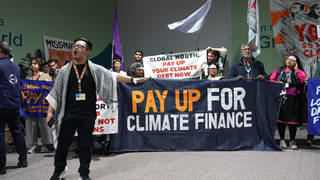
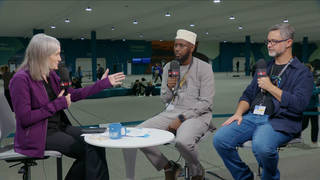
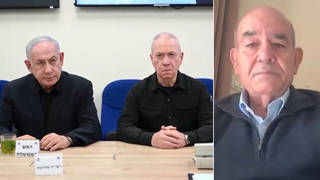
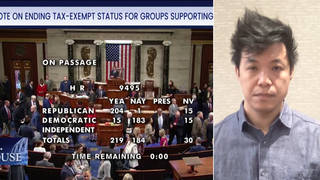
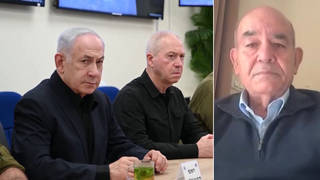





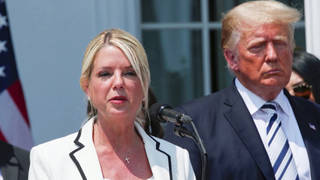
Media Options